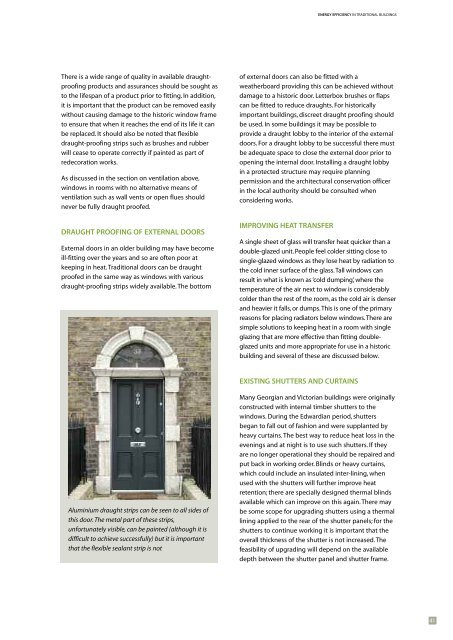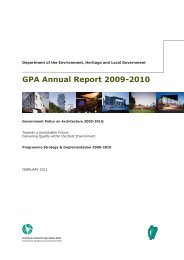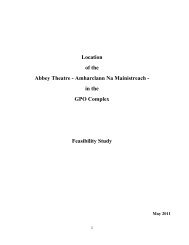Energy Efficiency in Traditional Buildings - Dublin City Council
Energy Efficiency in Traditional Buildings - Dublin City Council
Energy Efficiency in Traditional Buildings - Dublin City Council
You also want an ePaper? Increase the reach of your titles
YUMPU automatically turns print PDFs into web optimized ePapers that Google loves.
ENERGY EFFICIENCY IN TRADITIONAL BUILDINGS<br />
There is a wide range of quality <strong>in</strong> available draughtproof<strong>in</strong>g<br />
products and assurances should be sought as<br />
to the lifespan of a product prior to fitt<strong>in</strong>g. In addition,<br />
it is important that the product can be removed easily<br />
without caus<strong>in</strong>g damage to the historic w<strong>in</strong>dow frame<br />
to ensure that when it reaches the end of its life it can<br />
be replaced. It should also be noted that flexible<br />
draught-proof<strong>in</strong>g strips such as brushes and rubber<br />
will cease to operate correctly if pa<strong>in</strong>ted as part of<br />
redecoration works.<br />
As discussed <strong>in</strong> the section on ventilation above,<br />
w<strong>in</strong>dows <strong>in</strong> rooms with no alternative means of<br />
ventilation such as wall vents or open flues should<br />
never be fully draught proofed.<br />
DRAUGHT PROOFING OF EXTERNAL DOORS<br />
External doors <strong>in</strong> an older build<strong>in</strong>g may have become<br />
ill-fitt<strong>in</strong>g over the years and so are often poor at<br />
keep<strong>in</strong>g <strong>in</strong> heat. <strong>Traditional</strong> doors can be draught<br />
proofed <strong>in</strong> the same way as w<strong>in</strong>dows with various<br />
draught-proof<strong>in</strong>g strips widely available. The bottom<br />
of external doors can also be fitted with a<br />
weatherboard provid<strong>in</strong>g this can be achieved without<br />
damage to a historic door. Letterbox brushes or flaps<br />
can be fitted to reduce draughts. For historically<br />
important build<strong>in</strong>gs, discreet draught proof<strong>in</strong>g should<br />
be used. In some build<strong>in</strong>gs it may be possible to<br />
provide a draught lobby to the <strong>in</strong>terior of the external<br />
doors. For a draught lobby to be successful there must<br />
be adequate space to close the external door prior to<br />
open<strong>in</strong>g the <strong>in</strong>ternal door. Install<strong>in</strong>g a draught lobby<br />
<strong>in</strong> a protected structure may require plann<strong>in</strong>g<br />
permission and the architectural conservation officer<br />
<strong>in</strong> the local authority should be consulted when<br />
consider<strong>in</strong>g works.<br />
IMPROVING HEAT TRANSFER<br />
A s<strong>in</strong>gle sheet of glass will transfer heat quicker than a<br />
double-glazed unit. People feel colder sitt<strong>in</strong>g close to<br />
s<strong>in</strong>gle-glazed w<strong>in</strong>dows as they lose heat by radiation to<br />
the cold <strong>in</strong>ner surface of the glass. Tall w<strong>in</strong>dows can<br />
result <strong>in</strong> what is known as ‘cold dump<strong>in</strong>g’, where the<br />
temperature of the air next to w<strong>in</strong>dow is considerably<br />
colder than the rest of the room, as the cold air is denser<br />
and heavier it falls, or dumps. This is one of the primary<br />
reasons for plac<strong>in</strong>g radiators below w<strong>in</strong>dows. There are<br />
simple solutions to keep<strong>in</strong>g heat <strong>in</strong> a room with s<strong>in</strong>gle<br />
glaz<strong>in</strong>g that are more effective than fitt<strong>in</strong>g doubleglazed<br />
units and more appropriate for use <strong>in</strong> a historic<br />
build<strong>in</strong>g and several of these are discussed below.<br />
EXISTING SHUTTERS AND CURTAINS<br />
Alum<strong>in</strong>ium draught strips can be seen to all sides of<br />
this door. The metal part of these strips,<br />
unfortunately visible, can be pa<strong>in</strong>ted (although it is<br />
difficult to achieve successfully) but it is important<br />
that the flexible sealant strip is not<br />
Many Georgian and Victorian build<strong>in</strong>gs were orig<strong>in</strong>ally<br />
constructed with <strong>in</strong>ternal timber shutters to the<br />
w<strong>in</strong>dows. Dur<strong>in</strong>g the Edwardian period, shutters<br />
began to fall out of fashion and were supplanted by<br />
heavy curta<strong>in</strong>s. The best way to reduce heat loss <strong>in</strong> the<br />
even<strong>in</strong>gs and at night is to use such shutters. If they<br />
are no longer operational they should be repaired and<br />
put back <strong>in</strong> work<strong>in</strong>g order. Bl<strong>in</strong>ds or heavy curta<strong>in</strong>s,<br />
which could <strong>in</strong>clude an <strong>in</strong>sulated <strong>in</strong>ter-l<strong>in</strong><strong>in</strong>g, when<br />
used with the shutters will further improve heat<br />
retention; there are specially designed thermal bl<strong>in</strong>ds<br />
available which can improve on this aga<strong>in</strong>. There may<br />
be some scope for upgrad<strong>in</strong>g shutters us<strong>in</strong>g a thermal<br />
l<strong>in</strong><strong>in</strong>g applied to the rear of the shutter panels; for the<br />
shutters to cont<strong>in</strong>ue work<strong>in</strong>g it is important that the<br />
overall thickness of the shutter is not <strong>in</strong>creased. The<br />
feasibility of upgrad<strong>in</strong>g will depend on the available<br />
depth between the shutter panel and shutter frame.<br />
41

















